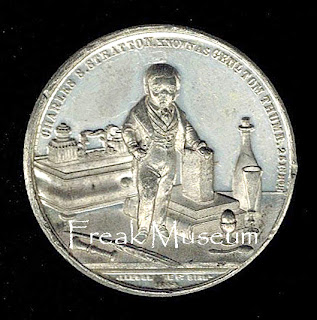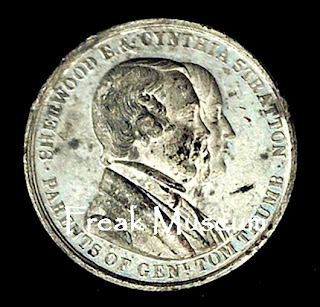With Apologies to Steven King
What follows is a selection of the
strange and curious items in my collection.
Tibetan Sorcerer's Crown
Silver chased and copper repousse, gold leaf,
hand polished turquoise and precious coral cabochons.
hand polished turquoise and precious coral cabochons.
Tibet, mid 19th century
Wax Museum Heads
All early 20th century
A. Lincoln
This French lady of the evening, is from a
Toulouse-Lautrec diorama
Wild Bill Hickok
Adult Male Platypus
Pocket Watch
belonging to
belonging to
Professor William Heckler Sr.
When asked for the time, Professor Heckler enjoyed taking this watch from his vest and saying,
"I'm not sure, look for yourself."
The watch case contains ten dressed fleas.
The watch case contains ten dressed fleas.
Egyptian Mummified Fish
The Lord's Prayer Engraved on the Head of a Pin
Coke bottle completely incrusted in coral
Ear of Corn with single bottom and double top
A Rabbit with 12 Horns
The placement and prominence of the horn on the nose
gives rise to this being a True Unicorn of the Wood.
Egyptian Mummified
Dorcas Gazelle
Dorcas Gazelle
This animal was a beloved pet of an ancient Egyptian who wanted it to
accompany them into the after-life. Upon it's death this Dorcas gazelle was
mummified with as much care as a human. The reeds on the head and neck
were to give it rigidity during the mummification process. The keratin casing
of the horns is missing, same as the specimen in the Egyptian Museum.
See Divine Creatures by Salima IkramAncient/dp/9774248589
Mummified gazelles are rare in any museum collection.
There are only two examples known in private hands.
There are only two examples known in private hands.
Medals & Tokens
Barnum's Museum Medal
Obverse with image of Barnum's Museum
in New York with legend "New York/ P.T. Barnum/ Proprietor"; reverse
with portrait of Barnum inside a laurel wreath flanked by flags, over
text:
"This immense establishment/ contains 500,000 curiosities,/ including birds, beasts, insects,/ fossils, minerals, marine specimens,/ Indian implements, suits of armour,/ statuary, coins, medals,/ choice paintings, rare engravings,/ grand cosmorama, aerial garden/ and lecture room, in which rich,/ diversified and talented/ entertainments are given,/ unsurpassed in the World./
Admission To The Whole, Only 25 Cents".
"This immense establishment/ contains 500,000 curiosities,/ including birds, beasts, insects,/ fossils, minerals, marine specimens,/ Indian implements, suits of armour,/ statuary, coins, medals,/ choice paintings, rare engravings,/ grand cosmorama, aerial garden/ and lecture room, in which rich,/ diversified and talented/ entertainments are given,/ unsurpassed in the World./
Admission To The Whole, Only 25 Cents".
General Tom Thumb Medal
Charles S. Stratton Known As Genl Tom Thumb 25 In High with view of Tom
on desk surrounded by books, glass, wine bottle and desk set, signed
Allen & Moore F: Birm 1844. Reverse has image of Tom Thumb's carriage with
statistics signed Pub. By P. T. Barnum. Struck in White Metal 38.5mm.
This version dated 1844, but believed to have been struck in 1862. Issued in Great Britain.
General Tom Thumb Medal
A rarely seen gold plated example.
Parents of General Tom Thumb Medal
General Tom Thumb Medal
Original 19th Century Dime Museum Mummy
Good enough to fool even an expert's cursory examination, this life-size fabricated "mummy" has
the typical features seen in such dime museum exhibits. A caved-in decomposed abdominal
opening in the chest wall shows an actual rib (animal), and a breast with nipple and aureola.
Great attention has been paid to the face, note the lips, eye lids and slightly depressed nose.
Recent research shows this dime museum mummy not to have been made by
Nelson Supply House as previously thought, but a "freak factory" operating in NYC.
There are four of these rare mummy exhibits in my collection.
At one time, these mummies were on display at the
Cliff House Museum near Sutro's Baths, San Francisco.
Original 19th Century Mummified Demon Child
Unlike the often seen Tate demon children, this rare example has an actual skin over the body. It is sewn up the back. The horns on the head appear as if growing out of the skull and through the skin. Same with the hoofs and claws. The tip of the tail, not visible in the above picture ends in a horn.
Typically, the abdomen is caved in but what is unusual is the penis seen on the left thigh.
Same 19th century New York studio as the above.
This is not from the Cliff House Museum.
Leg from a Polydactyl Horse
Please come back, more to come as time permits.







































No comments:
Post a Comment